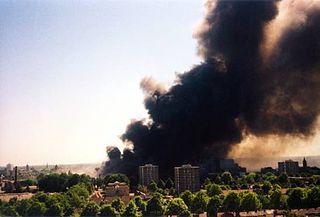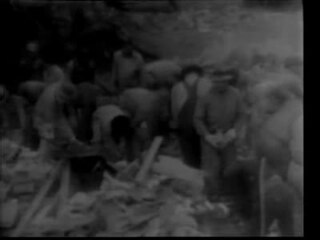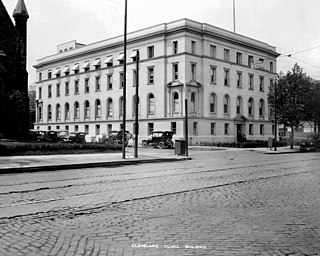
The Enschede fireworks disaster was a catastrophic fireworks explosion on 13 May 2000 in Enschede, Netherlands. The explosion killed 23 people including four firefighters and injured 950 others. A total of 400 homes were destroyed and 1,500 buildings were subsequently damaged.

On the morning of 6 December 1917 the French cargo ship SS Mont-Blanc collided with the Norwegian vessel SS Imo in the harbour of Halifax, Nova Scotia, Canada. The Mont-Blanc, laden with high explosives, caught fire and exploded, devastating the Richmond district of Halifax. At least 1,782 people were killed, largely in Halifax and Dartmouth, by the blast, debris, fires, or collapsed buildings, and an estimated 9,000 others were injured. The blast was the largest human-made explosion at the time. It released the equivalent energy of roughly 2.9 kilotons of TNT (12 TJ).

Dealey Plaza is a city park in the West End Historic District of downtown Dallas, Texas. It is sometimes called the "birthplace of Dallas". It was also the location of the assassination of John F. Kennedy in 1963. Thirty minutes after the shooting, Kennedy was pronounced dead at Parkland Memorial Hospital. The Dealey Plaza Historic District was named a National Historic Landmark on the 30th anniversary of the assassination, to preserve Dealey Plaza, street rights-of-way, and buildings and structures by the plaza visible from the assassination site, that have been identified as witness locations or as possible locations for the assassin.

On Monday, December 1, 1958, a fire broke out at Our Lady of the Angels School in Chicago, Illinois, shortly before classes were to be dismissed for the day. The fire originated in the basement near the foot of a stairway. The elementary school was operated by the Archdiocese of Chicago and had an enrollment of approximately 1600 students. A total of 92 pupils and 3 nuns ultimately died when smoke, heat, fire, and toxic gases cut off their normal means of egress through corridors and stairways. Many more were injured when they jumped from second-floor windows which, because the building had a raised basement, were nearly as high above ground as a third floor would be on level ground, approximately 25 feet (7.6 m).

The New London School explosion occurred on March 18, 1937, when a natural gas leak caused an explosion and destroyed the London School in New London, Texas, United States. The disaster killed more than 300 students and teachers. As of 2021, the event is the third-deadliest disaster in the history of Texas, after the 1900 Galveston hurricane and the 1947 Texas City disaster.

A gas explosion is the ignition of a mixture of air and flammable gas, typically from a gas leak. In household accidents, the principal explosive gases are those used for heating or cooking purposes such as natural gas, methane, propane, butane. In industrial explosions many other gases, like hydrogen, as well as evaporated (gaseous) gasoline or ethanol play an important role. Industrial gas explosions can be prevented with the use of intrinsic safety barriers to prevent ignition, or use of alternative energy.

Canisius High School is a Catholic, private college-preparatory school for young men run by the USA Northeast Province of the Society of Jesus in Buffalo, New York, United States, just north of the Delaware Avenue Historic District. Founded in 1870, the school has historical ties to Canisius College. Canisius operates independently from the New York State guidelines established by the Board of Regents. It has the largest high school student population among private schools in Western New York.

The Collinwood school fire was a major disaster that occurred at the Lake View School in Collinwood, Ohio, when a fire erupted on March 4, 1908, killing 172 students, two teachers and one rescuer. It is one of the deadliest school disasters in United States history.
Cleveland Hill UFSD is a K-12 school district within the Cleveland Hill hamlet of Cheektowaga, New York.

The Bath School disaster, also known as the Bath School massacre, was a series of violent attacks perpetrated by Andrew Kehoe upon the Bath Consolidated School in Bath Charter Township, Michigan, United States, on May 18, 1927. The attacks killed 38 children and 6 adults, and injured at least 58 other people. Prior to the explosions at the school, Kehoe had murdered his wife, Nellie Price Kehoe, and firebombed his farm. Arriving at the site of the school explosion, Kehoe died when he set off explosives concealed in his truck.

The Lake Erie College of Osteopathic Medicine (LECOM) is a private medical school and academic health center in Erie, Pennsylvania. LECOM has a Branch Campus in Bradenton, Florida and additional locations in Greensburg, Pennsylvania, and Elmira, New York. Founded in 1992, LECOM confers medical (D.O.), dental (DMD), podiatry (DPM), pharmacy (PharmD) degrees, as well as masters and doctoral degrees in the health sciences.

Canalside, formerly known as Canal Side and also referred to as Erie Canal Harbor, is a commercial and residential district in downtown Buffalo, New York. It is the recreation of the western terminus of the Erie Canal, which was destroyed in the early 20th century. Canalside is situated on the Buffalo River, in an area that was historically home to the Seneca people.

A major structure fire occurred at the Cleveland Clinic in Cleveland, Ohio, United States, on May 15, 1929. Flammable nitrocellulose X-ray film ignited in a basement storage room, emitting a poisonous yellowish-brown gas which spread throughout much of the Clinic and subsequently exploded several times. The fire claimed 123 lives including that of one of the Clinic's founders, Dr. John Phillips. Most of the deaths from the fire were due to toxic inhalation. Many were immediate; some were delayed by hours or even days. A policeman, Ernest Staab, rescued 21 victims from the fire, and left the scene, seemingly in good health. He later collapsed while working on his lawn, was hospitalized, but contrary to many contemporaneous newspaper articles survived and worked for the police department for another 25 years.

Anderson Street is a New Jersey Transit rail station on the Pascack Valley Line. The station is one of two rail stations in Hackensack and located at Anderson Street near Linden Street.

The Angola Horror train wreck occurred on December 18, 1867, just after 3 p.m. when the last coach of the Buffalo-bound New York Express of the Lake Shore Railway derailed at a bridge in Angola, New York, United States, slid down into a gorge, and caught fire, killing some 49 people. At the time, it was one of the deadliest train wrecks in American history.

Grover Cleveland High School was a high school located in Buffalo, New York. It is named for former U.S. president and Buffalo mayor Grover Cleveland and generally housed students from Grades 9 - 12, teaching according to the Board of Regents. Currently, the school building houses The International Preparatory School.

The Cleveland School fire was the fourth-deadliest school fire or explosion in American history and the deadliest fire in South Carolina history. It occurred near Camden, South Carolina, on May 17, 1923, during a school play, killing 77 people.

Erie was a steamship that operated as a passenger freighter on the Great Lakes. It caught fire and sank on August 9, 1841, resulting in the loss of an estimated 254 lives, making it one of the deadliest disasters in the history of the Great Lakes.

















